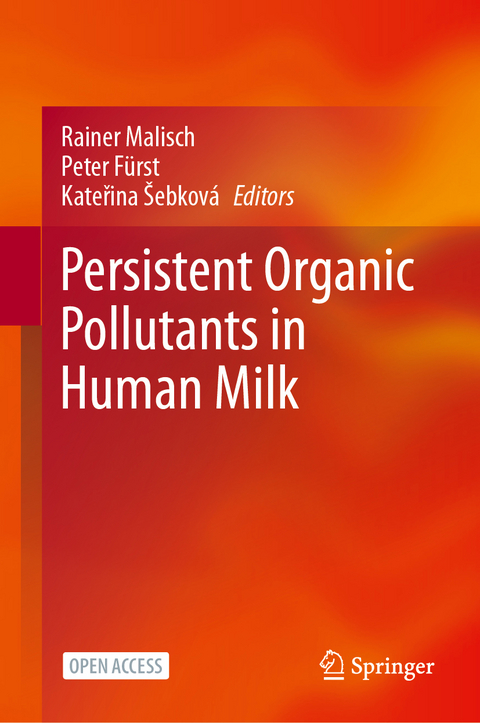
Persistent Organic Pollutants in Human Milk
Springer International Publishing (Verlag)
978-3-031-34085-7 (ISBN)
This open access book reviews the trends of persistent organic pollutants (POPs) in human milk and discusses the main findings of five global surveys that were coordinated by the World Health Organization (WHO) and the United Nations Environment Programme (UNEP) from 2000 to 2019. Human milk was selected as core matrix for human exposure under the Global Monitoring Plan for effectiveness evaluation of the Stockholm Convention on Persistent Organic Pollutants. Milk from well-defined groups of mothers was collected and mixed to form a representative sample per country. Datasets collected represent the largest global human tissues survey with a harmonized protocol, carried out in a uniform format for more than two decades. Altogether 69 countries participated in these studies between 2000 and 2015, and more than 40 countries participated in the study from 2016 to 2019.
Divided into 5 parts, the book offers an authoritative overview of human milk biomonitoring; collates the harmonized sampling requirements and analytical methods for the identification and quantification of contaminants in human milk; examines the results of the WHO/UNEP-coordinated exposure studies, including the identification of selected chlorinated pesticides, dioxin-like compounds, industrial chemicals like polychlorinated biphenyls (PCB) and chlorinated paraffins, polybrominated POPs and PFAS, among others; and traces geographic, temporal and cross-substance trends and correlations, and human health risks. The book finishes by providing the reader with the summary of the main findings and outlook from these studies, in which the comparison of concentrations found for the wide range of POPs listed in the Stockholm Convention allowed the identification of possible needs for actions and follow-ups in different countries/regions.
This book contributes to the understanding of exposure to hazardous chemicals and pollution as addressed by the UN Sustainable Development Goals onGood Health and Well-being (SDG 3) and will appeal to environmental and analytical chemists, researchers, professionals, and policymakers interested in learning more about contaminants in human milk. Given its breadth, this book will also appeal to a broader audience interested in maternal and child health.
Rainer Malisch is a food chemist. His doctoral thesis at the University of Münster, Germany, dealt with the environmental contamination by organochlorine pesticides, polychlorinated biphenyls and phthalates. Dr Malisch worked for the CVUA Freiburg, Germany, initially as head of the residue laboratory for veterinary drugs, later for dioxins and PCB. He supported the WHO/UNEP-coordinated exposure studies as head of the reference laboratory for determination of chlorinated and brominated POPs in human milk samples of the period 2000-2019. After designation of two Community Reference Laboratories (CRLs) to CVUA Freiburg in 2006, he became director of the CRL for Pesticides Residues in Food of Animal Origin and Commodities with High Fat Content (with this responsibility until 2010) and of the CRL for Dioxins and PCBs in Feed and Food. In 2010, the CRLs were renamed into “European Union Reference Laboratory” (EURL). In 2018, the tasks of the EURL for dioxins and PCBs were extended to all halogenated POPs (“EU Reference Laboratory for halogenated persistent organic pollutants (POPs) in Feed and Food”). He was member of several committees and commissions and retired in 2019. Peter Fürst studied Food Chemistry at the Universität of Münster/Germany where he received his PhD in 1982. From 1981 until his retirement in 2019, he joined the Chemical and Veterinary Analytical Institute Münsterland-Emscher-Lippe (MEL) and its legacy institutes where he held various positions. Since 2014, he was Chief Executive Officer of the institute which is a public-law institution. In 1988, he took a six-month sabbatical leave at the Centers for Disease Control, Atlanta/USA, and Health and Welfare, Ottawa/Canada. His main working areas are the investigation and assessment of organic contaminants in food, feed and human milk. He is a member of several European committees and commissions, including the Panel on Contaminants in the Food Chain of the European Food Safety Authority (EFSA) from 2006-2015. In 2009 he was appointed Honorary Professor at the Chemical Faculty of the University of Münster where he gives lectures since 1995 on „Chemistry and Analysis of Pesticides and Contaminants“ for students at the Institute of Food Chemistry. Kateřina Šebková is PhD in chemistry and the Director of the National Centre for Toxic Compounds and of the Stockholm Convention Regional Centre for capacity building and the Transfer of Technology, two bodies that are hosted by the RECETOX, the largest department of the Faculty of Science at the Masaryk University in Brno, Czech Republic. Before joining the RECETOX, she worked as a chemical expert and negotiator for the Czech Ministry of Environment in chemicals management, in particular on mercury and persistent organic pollutants, at the EU and the United Nations level. Her work comprises cooperation with Czech and international stakeholders, teaching, training and support policy-science communication and application of science in practice and building expert capacities in chemicals management and necessary legal and governance frameworks. She also works with international organizations such as the UN Environment, World Health Organization, UNIDO, UNDP and Secretariats of the multilateral environmental agreements protecting human health and environment as a consultant, trainer, and chairperson. Finally, she is coordinating the POPs monitoring in Central and Eastern Europe within the Stockholm Convention on POPs and is a member of the High-Level Roundtable on the EU Chemicals Strategy for Sustainability.
Part I Introduction.- Chapter 1 Human milk surveys on persistent organic pollutants from a historical perspective.- Chapter 2 Overview of WHO- and UNEP-coordinated human milk studies and their link to the Stockholm Convention on persistent organic pollutants.- Chapter 3 The Stockholm Convention, Global Monitoring Plan and its implementation in regional and global monitoring reports.- Part II Analytical methods and quality control.- Chapter 4 Analysis and quality control of WHO- and UNEP-coordinated human milk studies 2000-2019: polychlorinated biphenyls, polychlorinated dibenzo-p-dioxins and polychlorinated dibenzofurans.- Chapter 5 Analysis and quality control of WHO- and UNEP-coordinated human milk studies 2000-2019: organochlorine pesticides and industrial chemicals.- Chapter 6 Analysis and quality control of WHO- and UNEP-coordinated human milk studies 2000-2019: polybrominated diphenylethers, hexabromocyclododecanes, chlorinated paraffins and polychlorinated naphthalenes.- Part III WHO/UNEP-coordinated exposure studies 2000-2019: results of chlorinated and brominated POPs and discussion.- Chapter 7 WHO- and UNEP-coordinated human milk studies 2000-2019: findings of polychlorinated biphenyls, polychlorinated dibenzo-p-dioxins and polychlorinated dibenzofurans.- Chapter 8 WHO- and UNEP-coordinated human milk studies 2000-2019: findings of organochlorine pesticides and industrial chemicals.- Chapter 9 WHO- and UNEP-coordinated human milk studies 2000-2019: findings of polybrominated substances (PBDE, HBCDD, PBB 153, PBDD/PBDF).- Chapter 10 WHO- and UNEP-coordinated human milk studies 2000-2019: findings of chlorinated paraffins.- Chapter 11 WHO- and UNEP-coordinated human milk studies 2000-2019: findings of polychlorinated naphthalenes.- Part IV Assessments.- Chapter 12 Time trends in human milk derived from WHO- and UNEP-coordinated exposure studies; Chapter 1: polychlorinated biphenyls, polychlorinated dibenzo-p-dioxins and polychlorinated dibenzofurans.- Chapter 13 Time trends in human milk derived from WHO- and UNEP-coordinated exposure studies; Chapter 2: DDT, beta-HCH and HCB.- Chapter 14 Time trends in human milk derived from WHO- and UNEP-coordinated exposure studies; Chapter 3: perfluoroalkyl substances (PFAS).- Chapter 15 Risk-benefit analysis for the breastfed infant based on the WHO- and UNEP human milk surveys for dioxin-like compounds.- Part V Summary, conclusions and outlook.- Chapter 16 Overall conclusions and key messages of the WHO/UNEP-coordinated human milk studies on persistent organic pollutants.- Chapter 17 Outlook (towards future studies on human milk).
| Erscheinungsdatum | 13.10.2023 |
|---|---|
| Zusatzinfo | XXVII, 683 p. 318 illus., 309 illus. in color. |
| Verlagsort | Cham |
| Sprache | englisch |
| Maße | 155 x 235 mm |
| Gewicht | 1350 g |
| Themenwelt | Sachbuch/Ratgeber ► Natur / Technik ► Natur / Ökologie |
| Medizin / Pharmazie ► Medizinische Fachgebiete ► Pharmakologie / Pharmakotherapie | |
| Naturwissenschaften ► Biologie ► Ökologie / Naturschutz | |
| Naturwissenschaften ► Chemie ► Analytische Chemie | |
| Naturwissenschaften ► Chemie ► Technische Chemie | |
| Schlagworte | Biomonitoring Human Milk • chlorinated paraffins • Chlorinated Pesticides • Contaminants in Human Milk • Human Health Risks • maternal and child health • open access • Persistent Organic Pollutants • Polybrominated and Perfluoroalkane substances • polychlorinated biphenyls • Polychlorinated dibenzofurans • Polychlorinated dibenzo-p-dioxins • Polychlorinated naphtalenes • united nations environment programme • WHO/UNEP-coordinated global survey of human milk • World Health Organization |
| ISBN-10 | 3-031-34085-X / 303134085X |
| ISBN-13 | 978-3-031-34085-7 / 9783031340857 |
| Zustand | Neuware |
| Haben Sie eine Frage zum Produkt? |
aus dem Bereich


